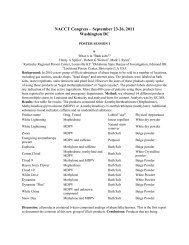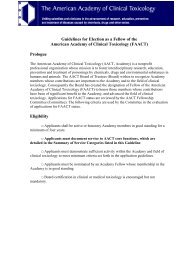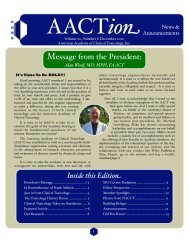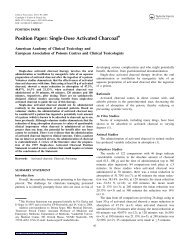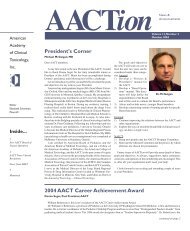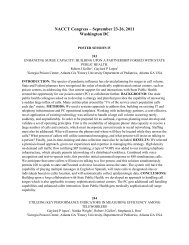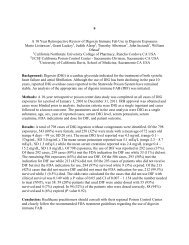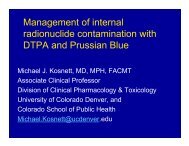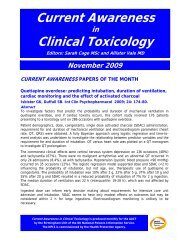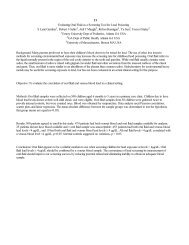NACCT Platform Abstracts 2012 - The American Academy of Clinical ...
NACCT Platform Abstracts 2012 - The American Academy of Clinical ...
NACCT Platform Abstracts 2012 - The American Academy of Clinical ...
You also want an ePaper? Increase the reach of your titles
YUMPU automatically turns print PDFs into web optimized ePapers that Google loves.
239<br />
OUTPATIENT EXPERIENCE OF HIP ARTHROPLASTY METAL ION EVALUATIONS<br />
Jerrold Leikin 1 , Patrick M Whiteley 2 , Brandon K Wills 3 , Kirk L Cumpston 3<br />
1 NorthShore University HealthSystem - OMEGA, Glenview IL USA<br />
2 Kaiser Hosptial, San Jose CA USA<br />
3 Virginia Commonwealth University Medical Center, Richmond VA USA<br />
OUTPATIENT EXPERIENCE OF HIP ARTHROPLASTY METAL ION EVALUATIONS<br />
Background: Last year, we presented our outpatient clinic experience <strong>of</strong> the first twenty <strong>of</strong> patient evaluations for elevated<br />
blood metal ion levels from metal-on-metal (MoM) hip arthroplasties. We now present additional data for 26 months involving<br />
32 patients.<br />
Methods: This was a consecutive series <strong>of</strong> patients presenting to two outpatient medical toxicology clinics from January 1,<br />
2010-March 1, <strong>2012</strong> with history <strong>of</strong> having undergone total hip arthroplasty. Presenting signs, symptoms, and interventions<br />
were reviewed. Available cobalt and chromium levels were summarized as median concentration with Interquartile Range<br />
(IQR).<br />
Results: A total <strong>of</strong> 32 patients were analyzed. <strong>The</strong> average age was 55.2 years (range 28 to 86 years). <strong>The</strong>re were 10 males<br />
and 22 females. Ten patients exhibited no symptoms and sought evaluation for gsymptom (n=7) while 2 other patients had<br />
been previously diagnosed with fibromyalgia. Twenty-five (78%) had pain described as hip or thigh pain, clicking sound with<br />
ambulation and/ or grinding with activity. Two (7%) patients had ataxia and later diagnosed with demyelination neuropathy with<br />
one patient demonstrating marked improvement after revision. Patients with MoM arthroplasties generally exhibit a tenfold<br />
increase in metal ion levels than traditional arthroplasties (Cobalt level 22.1 mg/mL IQR .9-59 in MoM vs. 1.25 ng/mL IQR<br />
0.9 to 2.6 in non-MoM). Finally, 17 (58.6%) patients had replacement or revision <strong>of</strong> their hip implant. Of these patients, 10<br />
(34.5%) had pre- and post-procedure cobalt and chromium concentrations. <strong>The</strong> median pre- and post-procedure cobalt<br />
concentrations were 44ng/mL (IQR 5-80) and 2.65ng/mL (IQR 1.2-4.1) respectively. <strong>The</strong> median pre- and post- procedure<br />
chromium concentrations were 31ng/mL (IQR 3.8-91) and 3.45ng/mL (IQR 1-8) respectively. No patients underwent<br />
chelation.<br />
Discussion: A significant number <strong>of</strong> individuals who seek toxicology consultation will either have minimal symptoms (fatigue,<br />
muscle aches) or be essentially asymptomatic (n=19 or 59%). Ion levels alone are not diagnostic for systemic toxicity.<br />
Documented neurotoxicity is extremely uncommon and, does not appear to be a dose-related phenomenon. <strong>The</strong> decision for<br />
hip revision solely for toxicologic reasons is exceptionally rare and usually involves a multidisciplinary approach. This series<br />
suggests that MoM arthroplasty can result in elevated cobalt and chromium concentrations. Most patients seeking toxicologic<br />
referral may be minimally symptomatic and seek guidance regarding elevated blood/serum metal ions; however, toxicologic<br />
based interventions are unusual.



